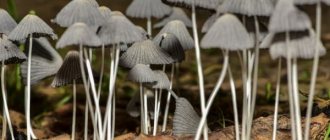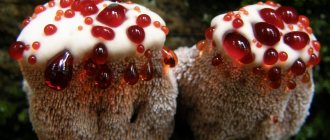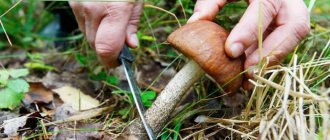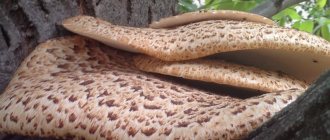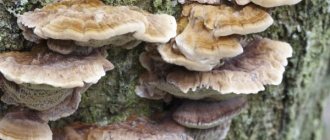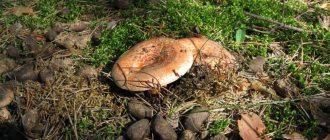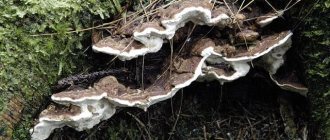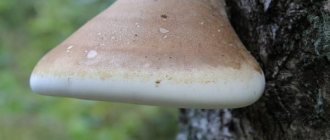| Polyporus umbellatus | |
| Polyporus umbellatus | |
| Scientific classification | |
| Kingdom: | Mushrooms |
| Separation: | Basidiomycetes |
| Class: | Agaricomycetes |
| Order: | Polyporals |
| Family: | Polyporaceae |
| Genus: | Polypore |
| Variety: | P. umbellatus |
| Binomial name | |
| Polyporus umbellatus (Person) Fri. (1821) | |
Polyporus umbellatus
a rare [
citation needed
], edible species of mushroom that grows on old roots.
beech trees or oak (for example [1]). It is also called tuberous bracket
and
umbrella polypore
.
Winter polypore (Polyporus brumalis)
Winter polypore (Polyporus brumalis) photo
Found from spring to autumn-winter frosts in single specimens or small groups on twigs immersed in the soil, as well as on trunks, roots and stumps of willow, birch, alder, rowan, hazel and other deciduous trees. The cap is elastic, then leathery, convex and flat, 1-10 cm in diameter, 0.2-0.8 cm thick. The surface of the cap is yellow, rusty, grayish-brown and almost black. Most often it is dirty brown or yellowish brown, later pale.
The underside of the cap is tubular. The leg is dense, cylindrical, 2-6 cm long, 3-10 mm thick, soft-velvety scaly, yellowish or brown. The spores are mostly white.
The winter tinder fungus is edible , category four. Only young caps are used (consumed boiled).
Metadata
This file contains additional information such as Exif metadata which may have been added by the digital camera, scanner, or software program used to create or digitize it. If the file has been modified from its original state, some details such as the timestamp may not fully reflect those of the original file. The timestamp is only as accurate as the clock in the camera, and it may be completely wrong.
| Camera manufacturer | FUJIFILM |
| Camera model | FinePix S9600 |
| Exposure time | 1/58 sec (0.017241379310345) |
| F-number | f/3.7 |
| ISO speed rating | 400 |
| Date and time of data generation | 07:31, 14 June 2007 |
| Lens focal length | 17 mm |
| Orientation | Normal |
| Horizontal resolution | 72 dpi |
| Vertical resolution | 72 dpi |
| Software used | Adobe Photoshop CS Macintosh |
| File change date and time | 23:30, 28 June 2007 |
| Y and C positioning | Co-sited |
| Exposure Program | Normal program |
| Exif version | 2.2 |
| Date and time of digitizing | 07:31, 14 June 2007 |
| Image compression mode | 2 |
| APEX shutter speed | 5.92 |
| APEX aperture | 3.8 |
| APEX brightness | 2.72 |
| APEX exposure bias | |
| Maximum land aperture | 3 APEX (f/2.83) |
| Metering mode | Pattern |
| Light source | Unknown |
| Flash | Flash did not fire, compulsory flash suppression |
| Color space | sRGB |
| Focal plane X resolution | 4,482 |
| Focal plane Y resolution | 4,482 |
| Focal plane resolution unit | 3 |
| Sensing method | One-chip color area sensor |
| Custom image processing | Normal process |
| Exposure mode | Auto exposure |
| White balance | Auto white balance |
| Scene capture type | Standard |
| Contrast | Normal |
| Saturation | Normal |
| Sharpness | Normal |
| Subject distance range | Close view |
Sheep tinder fungus. Sheep mushroom (Albatrellus ovinus)
Sheep tinder fungus. Sheep mushroom (Albatrellus ovinus) photo
It grows in dry coniferous forests, alone or in groups, sometimes fused with legs. The cap is up to 10 cm in diameter, 1-2 cm thick, round or somewhat irregular, with a tubercle, white, pale grayish, grayish-yellowish, slightly scaly, cracking in old age. The pulp is dense, white at first, then, when dry, lemon-yellow in color. The tubular layer is white.
Tubules 1-2 mm long, running down the stalk. Spore powder is white. The leg is up to 7 cm long, 2-4 cm thick, narrowed towards the base, white, smooth.
A little-known edible mushroom of the fourth category. Young caps of sheep polypores can be consumed boiled, fried and stewed.
Apuntes imprescindibles sobre el Polyporus, el hongo del drenaje linfático
Desde hace aproximadamente más de 1 000 años, este hongo se ha aplicado como antibiótico en la medicina tradicional china. El famoso Otzi, el hombre de hielo encontrado momificado en un glaciar del Tirol austríaco, portaba dos tipos de hongos políporos. Se sospecha que los usaba para protegerse de las infecciones.
El Polyporus es un hongo comestible que crece en grandes grupos alrededor de zonas arboladas de Europa y Asia. Aunque sus cualidades medicinales se han constatado en los primeros documentos médicos orientales, no es un alimento muy apreciado. Nutricionalmente, aparte de su contenido proteico, destaca por su relativa abundancia en cobre y zinc.
Branched polypore (branched, umbrella) (Polyporus umbellatus)
Branched polypore (branched, umbrella-shaped) (Polyporus umbellatus) photo
It grows at the base of trunks and stumps of deciduous trees, mainly oak, maple, and linden. Rarely seen, from August to November. The fruiting body reaches 50 cm in diameter and consists of numerous branched white stumps bearing small caps. The stumps at the base are connected into a common tuberous stalk. The caps are from 1.5 to 4 cm in diameter, round, flat-convex, with small depressions in the center, light brown or grayish-brown.
The pulp is white, fleshy, with a pleasant smell reminiscent of dill. The taste is delicate, nutty. The underside of the cap is tubular. The tubes are white, very short, running far down the stump.
Spore powder is white. The branched tinder fungus is edible , of the fourth category. It is used boiled, dried and salted.
Bibliography
- Wang Linli. Pharmaceutical properties of tinder fungus and its use in clinical practice // Medical Science of China. 2000,9(10): 58-59.
- Wang Sha Yan. The effect of a decoction of the polypore umbrella on mice suffering from kidney stones // Chinese Journal of Eugenics and Genetics. 2005,13(10): 39-40.
- Gou Xianjun, Zhang Weili, Huang Yuxia. Advances in the treatment of chronic hepatitis B with polypore polypore // Chinese Journal of Clinical Medicine. 2005,11(5): 680-681.
- Liu Bo. Chinese medicinal mushrooms. Shanxi: Science and Technology, 1978.
- Ma Xiaohong, Hao Guilan. Therapeutic effectiveness of polypore polypore Umbrella in relation to chronic hepatitis B // Profession and health. 2005,21(2): 300-301.
- Xujintang Chinese medicinal mushroom science. Beijing: Union Publishing House of Beijing Medical University and Xiehe Medical University of China, 1997.
- Xiao Linrong, Lin Li, Yang Rui Ying and others. Mushrooms and herbs. Beijing: China Medical Pharmaceutical Science and Technology, 2003.
- Tian GuanYan, Li TaiYuan. A comparative study of the effect of poliosis extracted from the sclerotium and mycelium of the polypore umbrella on the weight of the immunocompetent organs of mice // Agronomic Bulletin of Yanbian University 2005, 27(2): 83-86.
- Qun Shijian, Zeng Qingbo, Xie Guiquan. Experimental studies on the effect of the polypore umbrella on the chemoreology of the blood of a large mouse affected by nephritis // Chinese Practical Journal of Oriental and Western Medicine. 2004, 4(17): 1580—1582.%
- Yao Rennan, Huang Xiaojing, Xu Kailin. Impact of Polypore Umbrella poliosis on cancer cells HL-60 and K562 // Shandong Medicine. 2005, 45(14): 26-27.
Sulfur-yellow tinder fungus (Laetiporus sulphureus)
Sulfur-yellow tinder fungus (Laetiporus sulphureus) photo
Grows on living and dead trunks of willow and oak, less often on linden, poplar, birch and alder, from mid-May to the end of August. The caps are loosely fleshy, often fused into tiled masses, young ones are quite juicy, cheese-like, round or in the form of fan-shaped plates. Hats are sessile or with a short stem. The surface of the cap is orange, with a faint pinkish tint, subsequently turning pale, light leather or dirty pale ocher in color.
The lower surface of the caps is tubular, sulfur-yellow. The pulp is slightly yellowish, with a pleasant mushroom smell and sour taste. The spore powder is pale yellow. The sulfur-yellow tinder fungus is edible , category four.
Boiled young mushrooms are consumed.
File usage on other wikis
The following other wikis use this file:
- Usage on az.wikipedia.org
- Usage on be.wikipedia.org
- Usage on ca.wikipedia.org
- Usage on ceb.wikipedia.org Polyporus
- Polyporus umbellatus
- Portal:Houby
- Ysgwydd seimllyd
- Tüskegomba
- チョレイマイタケ
- Żagiew wielogłowa
- Polypores
- Polyporus
- Umbrella tinder fungus
- Polyporus umbellatus
- Polyporus
- Q675252
Scaly polypore (variegated). Elm (Polyporus squamosus)
Scaly polypore (variegated; variegated, variegated). Elm tree (Polyporus squamosus) photo
There are several names for this fungus in the literature: variegated tinder fungus, elm fungus, hare fungus, and variegated fungus. It grows on living and dead trees of various broad-leaved species, but most often on elm, elm and maple. Fruiting bodies appear annually in mid-May-June.
The cap is initially round, later kidney-shaped or fan-shaped, somewhat depressed towards the base. Its diameter is from 5 to 30 cm, thickness - 0.5-6 cm. The cap is elastic-fleshy, its surface is yellowish, creamy, ocher, the color of clay, with large brownish scales located concentrically. The underside of the cap is tubular, white or yellowish.
Spore powder is white. The leg (stump) is lateral, or eccentric, bent, less often straight, well developed, thick and dense. The upper part is reticulate-porous, white or yellowish, and the base is dark brown or almost black.
The pulp is soft and fleshy at first, but in older mushrooms it is hard, spongy-corky, and crumbly. The scaly polypore is edible at a young age, category 4. Used fresh, dried, in the form of mushroom powder, suitable for pickling after boiling.
References
1. Tan XL, Guo L, Wang GH. Polyporus umbellatus inhibited tumor cell proliferation and promoted tumor cell apoptosis by down-regulating AKT in breast cancer. Biomed Pharmacother. 2016 Oct;83:526-535. PubMed PMID: 27447121. 2. Zhang GW, Qin GF, Han B, Li CX, Yang HG, et al. Efficacy of Zhuling polyporus polysaccharide with BCG to inhibit bladder carcinoma. Carbohydr Polym. 2015 Mar 15; 118:30-5. PubMed PMID: 25542103. 3. Yoon JJ, Lee YJ, Lee SM, Kang DG, Lee HS. Oryeongsan suppressed high glucose-induced mesangial fibrosis. BMC Complement Altern Med. 2015 Feb 22; 15:30. PubMed PMID: 25880429; PubMed Central PMCID: PMC4354744. 4. Zhao YY. Traditional uses, phytochemistry, pharmacology, pharmacokinetics and quality control of Polyporus umbellatus (Pers) Fries: a review. J Ethnopharmacol. 2013 Aug 26;149(1):35-48. PubMed PMID: 23811047. 5. Hun Son K, Young Heo M. Inhibitory effects of Korean indigenous plants on tyrosinase and melanogenesis. J Cosmet Sci. 2013 Mar-Apr;64(2):145-58. PubMed PMID: 23578837. 6. Zhao YY, Zhang L, Long FY, Cheng XL, Bai X, et al. UPLC-Q-TOF/HSMS/MS(E)-based metabonomics for adenine-induced changes in metabolic profiles of rat faeces and intervention effects of ergosta-4,6,8(14),22-tetraen-3-one. Chem Biol Interact. 2013 Jan 25;201(1-3):31-8. PubMed PMID: 23246428. 7. Sun Y, Liang X, Zhao Y, Fan J. A sensitive spectrofluorometric method for determination of ergosta-4,6,8(14),22-tetraen-3-one in rat plasma, feces, and urine for application to pharmacokinetic studies using cerium (III) as a probe. Appl Spectrosc. 2013 Jan;67(1):106-11. PubMed PMID: 23317677. 8. Dai H, Han XQ, Gong FY, Dong H, Tu PF, et al. Structure elucidation and immunological function analysis of a novel β-glucan from the fruit bodies of Polyporus umbellatus (Pers) Fries. Glycobiology. 2012 Dec;22(12):1673-83. PubMed PMID: 22717313. 9. Zhao YY, Zhang L, Mao JR, Cheng XH, Lin RC, et al. Ergosta-4,6,8(14),22-tetraen-3-one isolated from Polyporus umbellatus prevents early renal injury in aristolochic acid-induced nephropathy rats. J Pharm Pharmacol. 2011 Dec;63(12):1581-6. PubMed PMID: 22060289. 10. Li X, Xu W. TLR4-mediated activation of macrophages by the polysaccharide fraction from Polyporus umbellatus(pers) Fries. J Ethnopharmacol. 2011 Apr 26;135(1):1-6. PubMed PMID: 20600759. 11. Zhang G, Zeng X, Li C, Li J, Huang Y, et al. Inhibition of urinary bladder carcinogenesis by aqueous extract of sclerotia of Polyporus umbellatus fries and polyporus polysaccharide. Am J Chin Med. 2011;39(1):135-44. PubMed PMID: 21213404. 12. Zhao YY, Qin XY, Zhang Y, Lin RC, Sun WJ, et al. Quantitative HPLC method and pharmacokinetic studies of ergosta-4,6,8(14),22-tetraen-3-one, a natural product with diuretic activity from Polyporus umbellatus. Biomed Chromatogr. 2010 Oct;24(10):1120-4. PubMed PMID: 20853466. 13. Li X, Xu W, Chen J. Polysaccharide purified from Polyporus umbellatus (Per) Fr induces the activation and maturation of murine bone-derived dendritic cells via toll-like receptor 4. Cell Immunol. 2010;265(1):50-6. PubMed PMID: 20673883. 14. Zhang G, Zeng X, Han L, Wei JA, Huang H. Diuretic activity and kidney medulla AQP1, AQP2, AQP3, V2R expression of the aqueous extract of sclerotia of Polyporus umbellatus FRIES in normal rats. J Ethnopharmacol. 2010 Mar 24;128(2):433-7. PubMed PMID: 20083182. 15. Zhao YY, Xie RM, Chao X, Zhang Y, Lin RC, et al. Bioactivity-directed isolation, identification of diuretic compounds from Polyporus umbellatus. J Ethnopharmacol. 2009 Oct 29;126(1):184-7. PubMed PMID: 19665537. 16. Xiong LL. . Zhongguo Zhong Xi Yi Jie He Za Zhi. 1993 Sep;13(9):533-5, 516-7. PubMed PMID: 8111209.
Scaly polypore, elm polypore (Polyporus squamosus)
Scaly polypore Polyporus squamosus
Fruiting body
(up to 2 mm). The leg is lateral, less often eccentric, dense, thick, short, dark at the base, scaly. The flesh is whitish, soft in young specimens, spongy-corky in old specimens, but with a pleasant aroma.
Season and place
Begins to grow in spring on dead and living deciduous trees. Often several mushrooms are placed one above the other.
Similarities
You can’t confuse it with anything: the dark brown scales of the cap, the black base of the stem, and the very size of the mushroom.
Grade
The best sites on the topic: Tinder fungus
Edible mushrooms | Sulfur-yellow tinder fungus | Grifola curly...
Description of mushrooms - edible mushrooms
, mushroom identification.
... The fruiting body polypore
consists of fused, initially tongue-shaped ...Polypores - Edible and poisonous mushrooms
Polypores
|
Basidal mushrooms
|
Types of mushrooms | Edible
and poisonous... This group includes
mushrooms
that settle mainly on...Sulfur-yellow polypore - Wikipedia
Laetiporus sulphureus) - mushroom
-
tinder fungus
of the Polyporaceae family.
It is considered conditionally edible
, but sometimes it can have some... Description - Synonyms - Ecology and distribution - Similar speciesPolypores Edible mushrooms, wild berries, medicinal herbs
Polypores
- this is a fairly large group of fungi, parasitic mainly on trees, but quite often they also inhabit dry fallen ...
Pictures upon request Tinder fungus - edible
Edible tinder fungi - description and recipes » Gifts of the forest
Polypores
—
mushrooms
growing on trees belong to different families and are united only by a similar appearance and way of existence. Among …Polypore - a mushroom for weight loss, photo - Mushrooms
«Tinder fungus
" is the collective name for parasitic mushrooms, ... Some of them are conditionally
edible
mushrooms that require special ...
Growing methods
The umbrella tinder fungus is grown mainly in two ways:
- To grow tinder fungus using this method, it is necessary to maintain the following conditions: relative humidity in the room more than 80%, air temperature 20 ± 2 °C, constant air circulation and natural changes in lighting. The substrate for the growth of the fungus is a mixture of various solid plant residues (shavings, bark, corn cobs, sawdust, small branches, reeds, etc.), which are poured with boiling water. After the mixture has cooled to room temperature, squeeze it well and mix with mycelium at the rate of 100 g of mycelium per 35 kg of substrate. The resulting mixture is placed in transparent plastic bags, tied, several small holes are made for ventilation and placed in a specially prepared room. After the first shoots appear, cuts are made in the bag to allow the mushrooms to emerge. The first wave of seedlings should be expected 30-40 days after planting.
- Growing takes place under natural conditions. The observed effect from this method should be expected no earlier than 4 months after planting the mycelium. The substrate is hemp and wooden blocks. For 100 g of mycelium, take 35 kg of substrate. The prepared substrate is soaked in water for 3-4 days. Notches are made in the bars or holes are drilled, which are filled with mycelium (100 g of mycelium per 35 kg of wood), then covered with leaves or pieces of bark. The bars with the mushroom are placed in a shady place, sometimes digging in a little. In dry times, watering is recommended. Planting can be done at any time of the year. Fruiting begins under optimal environmental conditions and occurs 4-5 times a year.
Interesting Facts
You can also add the following about the umbrella tinder:
- On Russian territory this mushroom is quite rare (even listed in the Red Book), but in China it is much more common and is very popular as an edible mushroom. The Chinese boil and fry it.
- Only young mushrooms are edible and tasty; old ones are bitter.
- Polypores are widely used in homeopathy and traditional medicine to remove excess fluid from the body (for example, for edema).
- Since polypores are saprotrophs, they can be grown artificially on a suitable substrate (for example, sawdust).
But there are also categories of people for whom such nutrition is not indicated: these are children, allergy sufferers and those suffering from diseases of the stomach and intestines.

